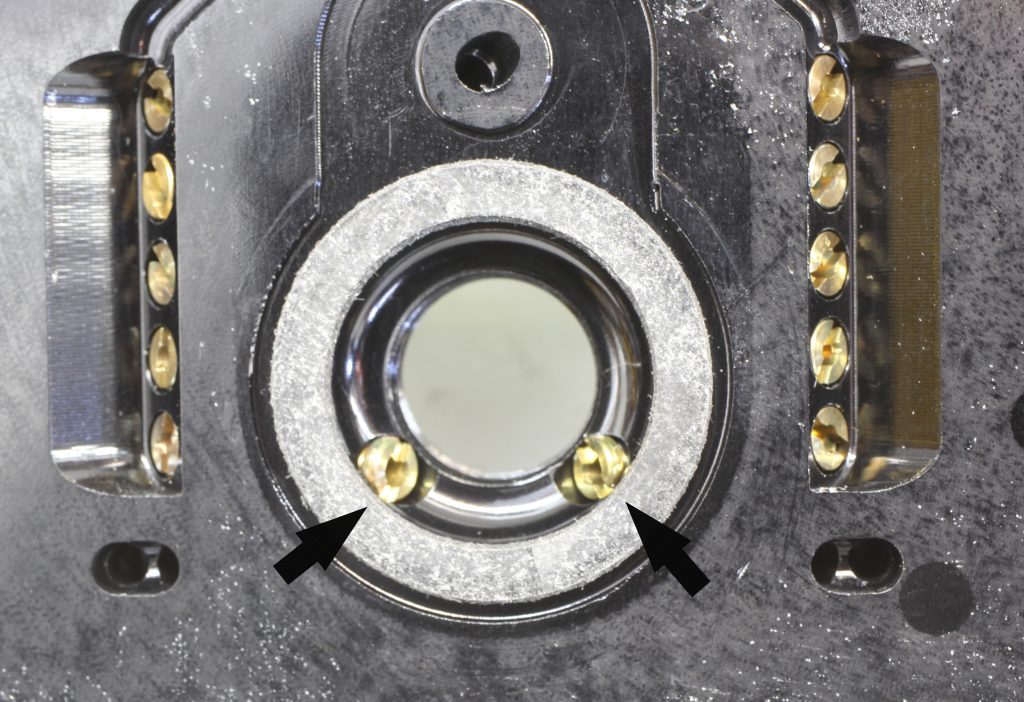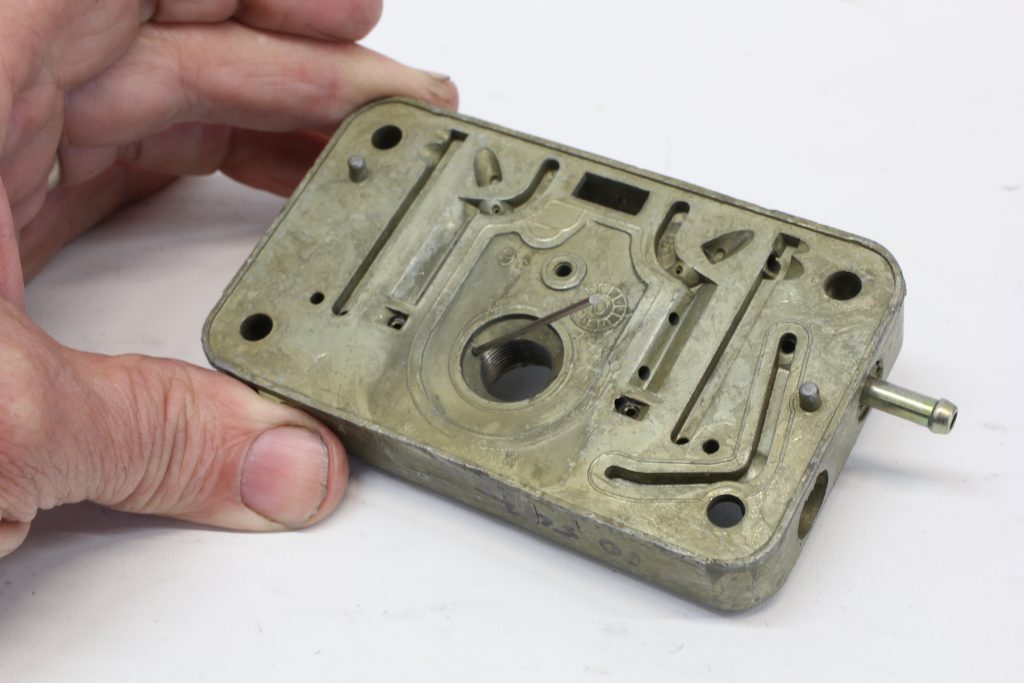I’ve read your article on carb tuning about 5 times. I have a 650 cfm SS-AN annular discharge Quick Fuel carburetor with the changeable jets behind the power valve. Are they called emulsion jets? I’m trying to change mine and I can’t seem to find a kit let alone find the name of them. I know they are smaller than the air bleeds on top of the carb. Any help would be great.
S.D.
The restrictors located behind the power valve are called power valve channel restrictors (PVCR). They are generally the same thread size as the emulsion restrictors that are located in the main well of the metering block. These are a 6-32 thread size. The emulsion bleeds you mentioned are the two, three, or sometimes five little restrictors located vertically in the main well of the metering block. The air bleeds you mentioned are the ones on top of the carburetor venturi and use a larger 10-32 thread size.

Depending upon the model of your Quick Fuel carb, those PVCRs can be changed by using the same 6-32 screw-in brass restrictors used in the main metering well. If you don’t know the size of your PVCR restrictors, you can call Holley’s tech line and they can tell you. All you need is your carb part number (SS-650-AN). If you bought the carb new, the Quick Fuel carburetors come with a printed card in the box that details all the internal circuit sizes including the PVCR.
How to Measure Restrictor Size
If you don’t have the card, measuring these restrictors accurately will require a set of small, specialty tools called pin gages. These are calibrated pins in 0.001 inch increments usually sold as a kit from 0.010 inch to 0.060 inch. These pins allow you to accurately measure the existing PVCR size which will then let you decide which direction you want to go.
Accuracy is important because with these small restrictors, a change of 0.002 inch diameter is a big change in area. Using a 0.050 inch PVCR as an example, if we change to a 0.048 inch diameter, this 0.002 inch reduces the flow area by eight percent, so you can see why accurate measurements are important.

Determining Your Ideal Restrictor Sizing
The individual and I ended up trading emails a couple of times about his specific application, are he was asking about the PVCR restrictors for a street-driven car. He wanted to enlarge the PVCR a couple of sizes and then reduce his primary main jets by a comparable amount of flow area. This is helpful for street engines where light throttle may produce a rich air-fuel ratio when the carb is running on the primary main jets. This often occurs at roughly 20 to 25 percent throttle opening at a point before the power valve opens.
By increasing the PVCR size, when heavier throttle is applied and the power valve opens, the larger PVCR will compensate for the leaner jetting in the main jets. This is a way to allow the engine to run somewhat leaner during street driving yet still have sufficient fuel flow to keep the air/fuel ratio safe under heavier throttle action. This would be especially helpful if you were tuning a Holley two-barrel carb where you don’t have the luxury of second pair of throttle bores and jets to make up for slightly leaner primary side.
If You Don’t Have Screw-In Bleeds…
Up until now, we have discussed changing the PVCR by using screw-in bleeds. However, many Holley carburetors are not fitted with screw-in bleeds. This makes these changes more difficult since increasing the PVCR size will mean permanently drilling the hole larger. While this can be accomplished simply enough, this permanent change makes reducing the flow area more difficult. One way would be to fill the restrictors with epoxy and then re-drill them in a smaller size. At that point it might be worth the money to invest in a billet aluminum metering block that is already fitted with screw-in bleeds that allow quick and easy changes to not only the PVCR but also the idle feed restrictors and the emulsion bleeds.
None of this is required tuning for a mild street car where you may not care if the primary heavy cruise air/fuel ratio is a tad rich. But if you’re one of those few who enjoy tinkering with a carburetor to extract the ultimate performance, there are improvements to be had with these tweaks that will offer excellent part-throttle performance without the complexity of EFI.
Quick Fuel Bleed Restrictor Parts List
- Quick Fuel 6-32 bleed restrictor, 0.032″ – QFT-7-32QFT
- Quick Fuel 6-32 bleed restrictor, 0.040″ – QFT-7-40QFT
- Quick Fuel 6-32 bleed restrictor, 0.057″ – QFT-7-57QFT

How does this relate to jet size change? For example; is 0.010 change affectively 5 main jets size?
Below is how you square jets with a PV you just need to know the diameter of the opening in decimal inches and the rest is simple math. Simple if you still remember, I did not so this will be a good refresher if you are like my forgetful A$$. See the Holley standard jetting chart for drill size. You will notice a lot of the jets are the same drill size. More on that in the video later this week. on my YouTube
I did area and volume. Volume because why not, it’s just one more step after area with the length. This was an approximate length measurement because it is hard to measure the small tolerances correctly.
Note: USA car guys do everything in decimal inches
Area of a .105 91 Jet ( Hole size .105 x Length .194 )
A= π X R²
1. .105 ÷ 2 = 0.0525 ( Radius is Diameter in half )
2. .0525 x .0525 = 00275625
3. .00275625 x 3.14 = .008654625
4. Area .008654625
5. .008654625 x .194 = 0.00167899725 Volume
Area of a .105 73 Jet ( Hole size .079 x Length .194 )
1. .079 ÷ 2 = 0.0395
2. .0395 x .0395 = 00156025
3. .00156025 x 3.14 = .004899185
4. Area 004899185
5. .004899185 x .194 = 0.00095044189 Volume
Area of PVR .062 ( Hole size .062 x Length .15 )
1. .062 ÷ 2 = 0.031
2. .031 x .031 =000961
3. .000961 x 3.14 = .00301754
4. Area.00301754
5. .00301754 x .15 = 0.000452631 Volume
PVR .00301754 + 73 Jet .004899185 = .007916725 Total area
compared to rear jet for fueling.
Area
Front .007916725
Rear .008654625
You can see I am off on the fueling and need to make an adjustment.
Volume
Front .00140307289
Rear .00167899725
I have a holley alcohol carb and the carb was took apart I’m putting back together and the metering plates have the jets under power valve .my question is one meeting plate had the holes under power valve blocked and the other plate has jets in it with holes like should I’m not shure what muttering bolt is front or back .it alcohol dirt track carb quick fuel
Hi; I have a holley 950 xp it has a slight surge at transition? Its not to bad I changed jets and airbleeds Idles perfect. Just trying to make better.
Any ideas. thanks Greg
Gonna hurt your brain. Holley 84014. Summit now sells it as it’s racing carb. Simple but difficult to make changes. Going on a 383 stroker 11.1 compression. What do I do with it. No I’m not going to throw it away.